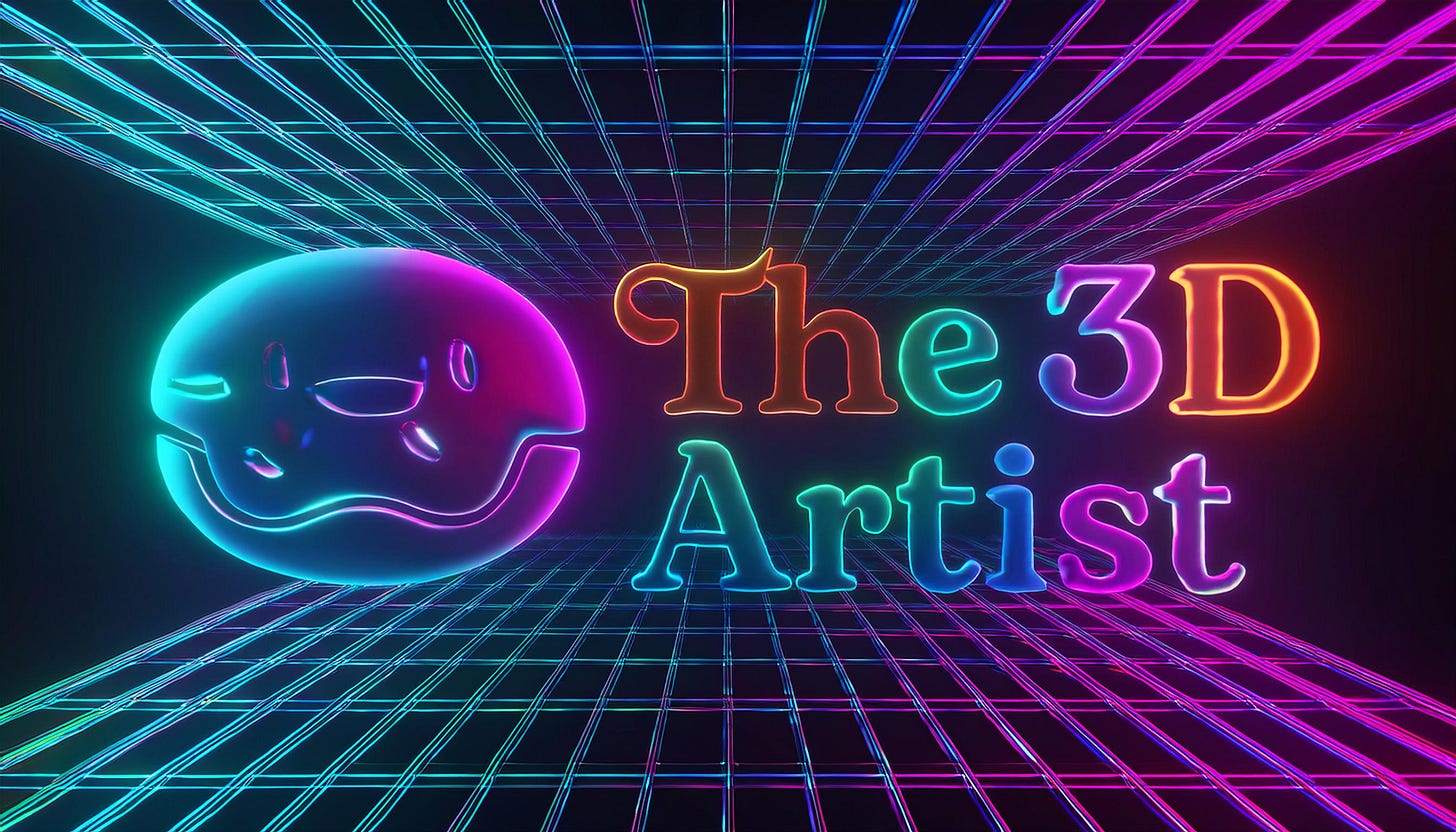The Internet’s Z-Axis: A New Horizon for 3D Artists
Why 3D Artists Should Prepare for a New Wave of Opportunities
"The internet will soon have a z-axis."
This profound statement was uttered at Siggraph a couple of weeks ago and has stuck with me ever since. Somewhere during the conference my mind turned to complete mush so I’m not sure who said it—so if you’re the originator of this idea and happen to be reading, please reach out, and I’ll give you the credit you deserve. (It was my buddy Banks from KitBash3D!)
But the sentiment is true. The internet, traditionally a 2D experience filled with text, images, and videos, is on the brink of a revolution. A revolution where depth—the third dimension—will become a core part of an interactive, online experience.
What Does This Mean?
At its core, the idea of the internet having a z-axis refers to the increasing integration of 3D content into the web. We’re talking about a future where online interactions go beyond flat screens and two-dimensional interfaces, and instead, immerse users in a world of 3D content. This could manifest in various forms:
AR Product Placement & Virtual Try-on: Visualize any object in your space before buying. Ensure that the bookshelf will fit in your living room. Put on an AR version of those shoes to see how they work with that outfit you plan on wearing to the wedding.
Web AR Experiences: Imagine shopping online and interacting with a 3D version of a product, spinning it around, and examining it from every angle before making a purchase.
3D Walkthroughs: Picture yourself walking through a 3D version of an apartment or house you’re considering renting or buying, all from the comfort of your current home. Or move through a gallery and view famous works of art from across the world.
These examples don’t consider the possibility of AR, VR, and Spatial Experiences becoming far more prevalent with the potential of widespread adoption of headset devices and glasses. The possibilities are expanding rapidly, and we’re on the cusp of a significant shift in how we experience the internet.
The Impact on 3D Artists
For most of us, 3D has been about using three-dimensional tools to create two-dimensional images. Whether it’s film, video games, commercials, product visualization or architectural renderings, the end product is typically a 2D image or video. The 3D models, lighting, and textures we create are a means to that end.
But in the coming world of the z-axis internet, this will change. The 3D model itself will become the final deliverable. We will no longer be solely creating assets to be rendered as images or animations; the 3D object will be the product, ready to be used in various interactive experiences across the web.
The Shift in Industry Demand
Some companies are already catching on. They see the writing on the wall and are beginning to invest in creating 3D models of their products, preparing for a future where these models will be essential. Whether it’s for virtual reality (VR) experiences, augmented reality (AR) applications, or web-based interactive 3D content, having a 3D representation of a product will be as vital as having a website or a social media presence.
This is reminiscent of the late 1990s when companies debated the need for a website.
“We’re a construction company…why would we need a webpage?”
Or the mid-2000s when social media was dismissed as something for people to maintain contact with family members and high school crushes.
“We’re Wendy’s. Why would we need a Twitter account?”
We all know how those stories ended—companies that embraced these technologies early on reaped significant rewards, while those that hesitated were left scrambling to catch up.
(FYI…Wendy’s Twitter account is fantastic.)
A New Wave of Opportunities
For 3D artists, this shift is exciting news.
I know there will be skeptics who say, “This is great, but they’ll soon use AI to create these digital versions of their products.”
The truth is they won’t. Every company I’ve worked with is extremely detailed about how it handles its branding and representations of its products. The brand colors, the shape of the bottle, the way it is lit, and the camera angles all get meticulously critiqued and helped to the highest of standards. There is no room for “good enough” in these situations, and AI can’t cut it with this level of detail and control. This will be a job for human creators for the foreseeable future.

So, while the entertainment industry may be experiencing a downturn, and jobs might seem scarce, there’s a significant wave of opportunities coming. As the internet embraces its z-axis, the demand for 3D content creation will skyrocket, opening doors for those who know how to create these immersive experiences.
The future is 3D, and it’s coming faster than we think. As artists, we need to be ready to ride this wave and shape the next generation of the World Wide Web.
The 3D Artist Community Updates!
This past Wednesday, August 14th we hosted a fantastic Live AMA with Sylwia Szymczyk!
Sylwia began as a seamstress and now leads 3D fashion projects at Timberland’s Digital Product Creation team. She's an advocate for tech integration and is a skilled artist working in Vstitcher, CLO3D, and Unreal Engine.
3D News of the Week
Huge Turnout For Animation Solidarity Rally Ahead Of AMPTP Negotiations - Cartoon Brew
Figma releases Vector to 3D - Figma
This on-demand 3D weaving machine could help solve the fast-fashion crisis - Fast Company
Speedtree 10 released - Speedtree
Learn How to Create a Beautiful Dreamy Cyborg in 3D - 80.lv
SuperSplat is a free online editor for 3D Gaussian Splats - CGChannel
3D Merch is here!
3D Tutorials
3D Jobs Incoming!!!
How would you feel about making $200k+ as a 3D Design Techonologist at Amazon!?!
3D Job Spreadsheet
Link to Google Doc With A TON of Jobs in Animation (not operated by me)
Hello! Michael Tanzillo here. I am the Head of Technical Artists with the Substance 3D Growth team at Adobe. Previously, I was a Senior Artist on animated films at Blue Sky Studios/Disney with credits including three Ice Age movies, two Rios, Peanuts, Ferdinand, Spies in Disguise, and Epic.
In addition to his work as an artist, I am the Co-Author of the book Lighting for Animation: The Visual Art of Storytelling and the Co-Founder of The Academy of Animated Art, an online school that has helped hundreds of artists around the world begin careers in Animation, Visual Effects, and Digital Imaging. I also created The 3D Artist Community on Skool and this newsletter.
www.michaeltanzillo.com
Free 3D Tutorials on the Michael Tanzillo YouTube Channel
Thanks for reading The 3D Artist! Subscribe for free to receive new posts and support my work. All views and opinions are my own!










